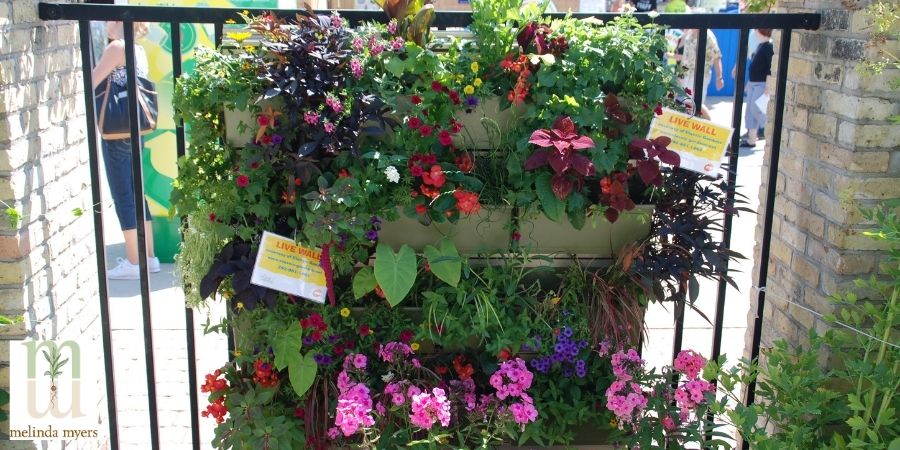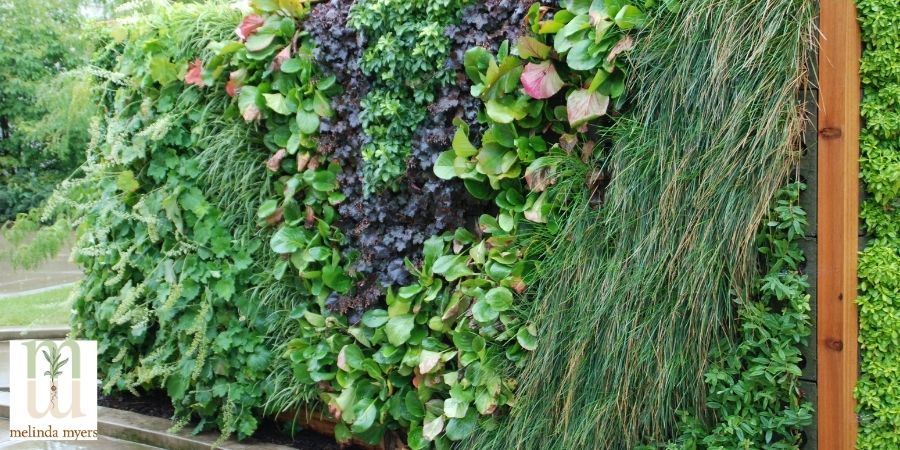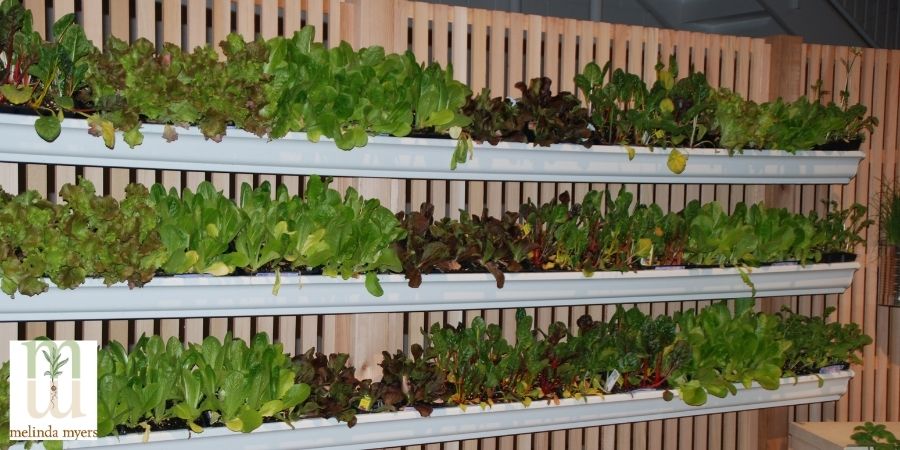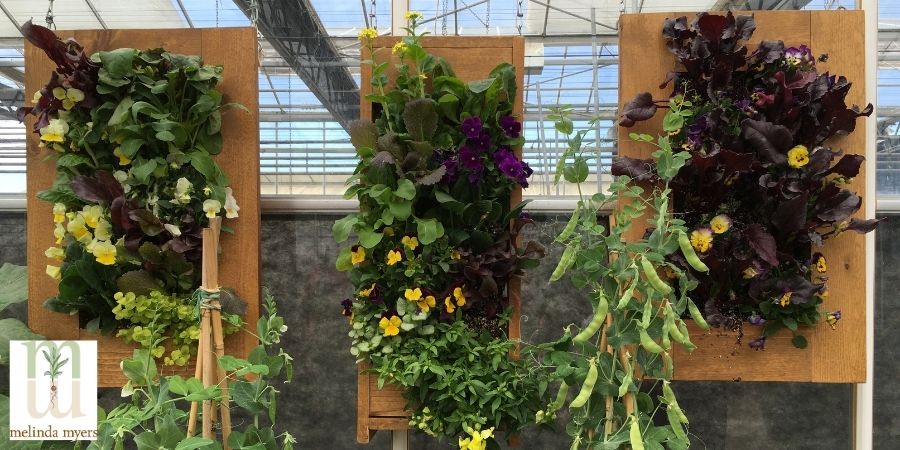How to Grow a Vertical Garden
- horticulturist and gardening expertMarch 13, 2021
Vertical gardening has been used for centuries to grow food, create, and provide privacy. New technologies and strategies have increased outdoor vertical gardening opportunities for all gardeners, especially those with limited space.
I was a small space gardener for more than 25 years and employed a variety of strategies to save space, plant more and create privacy in my small city lot. Now I have a much larger space to grow plants but still find vertical gardening helps me grow healthier gardens and create the landscape I desire.
As you design your space consider the views you want to keep. Viewing a pretty garden, keeping a watch on the children’s play area, or watching birds at the feeder can enhance your enjoyment. Strategically space screens and plantings leaving openings to views you want to keep.

Vertical Planter
Trellis, Obelisks, and Other Supports for Outdoor Vertical Gardens
Training vines up a trellis, onto a fence, over an arbor, or onto any type of DIY or purchased plant supports is one form of vertical gardening. Many of you may already use these strategies in your vegetable garden or outdoor living spaces.
Growing pole beans, peas, squash, melons, tomatoes, and other vining edible plants onto supports saves growing space, reduces the risk of disease, and makes harvesting easier. Secure the large fruits of melons and squash onto the support to prevent them from breaking off the vine. Place a sling of netting, cloth, or old nylon stocking under the fruit when a few inches in diameter and secure the sling to the supports.
Growing vertically increases airflow around and sunlight to all parts of the plants helping reduce the risk of powdery mildew, leaf spot, and other fungal diseases. Training tomatoes onto a stake or inside a tower lowers the risk of insect damage as well as disease.
Add some fun, save money and reduce waste by giving discards a second life as plant supports. Long tool handles can be secured to form a teepee for growing pole beans. Train cucumbers, squash, and melons onto an old gate. Mount an old bike rim onto a post for training peas and beans. Run a string from the bike rim and anchor it to the ground with metal wickets.
Use vine-covered trellises to screen a bad view, define a space and act as a sound barrier. Check the view while sitting or standing depending on how you will use the space. Listen and identify any source of noise you need to muffle. I used plants to provide sound and visual screening on my upstairs balcony when living on my small city lot. Hanging baskets and containers of tall tropical plants blocked my view of my neighbor’s house and her view of my balcony.
Create your visual screen quickly by training annual flowering vines like hyacinth bean, cardinal vine, or climbing nasturtiums onto a trellis or fence. Pole beans and Malabar spinach make edible and attractive annual options. Use perennial vines like the native honeysuckle vine, clematis, or climbing roses for years of color. Mix the two to quickly cover the trellis while waiting for the perennial vine to establish and reach its mature size. Plant two vines with different bloom times on one trellis to extend the colorful flower display. Or look for those that bloom at the same time to double the floral impact.

Deschampsia, Bergenia, Pachysandra, Hypericum, Heuchera, Carex Garden Wall
Create a living shade canopy using larger vines like grapes Virginia creeper and American bittersweet trained over arbors, pergolas, and other structures to provide needed shade. These deciduous vines drop their leaves during the winter allowing warm sunlight through while the leaves provide welcome shade during the warmer growing season.
Keep in mind the impact these vines have on plants growing under the shaded structure. Some plants will appreciate the shade while sun lovers will decline. Select plants that are suited to these growing conditions. Then consider any mess from falling flowers and impact from any edible fruit like grapes that provide a tasty treat for you and uninvited guests like squirrels and birds.
Some vines have twining stems, tendrils, or use other means to attach to the support. Once guided to the supports they attach and usually need minimal direction from you. Others need to be tied to the support with twist ties or twine initially and as they continue to grow.
Containers and Tall Narrow Plants for Outdoor Vertical Gardens
If looking for other options consider containers filled with tall grasses, tropical plants, flowers, or trellised vines. Place a couple to block a narrow view or line up several to separate your private outdoor space from the rest of the landscape. A row of narrow upright trees like Urban and North Pole apples can do the same. Check the tags to make sure whatever plant you select will thrive in the growing conditions and fit in the space once mature.
Espaliered trees are living works of art that can create open screening or dress up a bare wall or fence. Fruit or ornamental trees can be pruned into a decorative pattern. This is not something for those that are reluctant, unwilling, or unable to regularly prune these plants keeping them in the desired shape.
Outdoor Garden or Living Walls
Green walls are another way to add greenery to your outdoor rooms or where planting space is unavailable. You’ll find a variety of options to purchase and plans for making your own. Make sure whatever option you choose is secure once in place, weatherproof, and relatively easy to maintain.
An easy option is dressing up an existing wall or fence with containers. You can purchase pots from your favorite garden center or turn recycled cans, old boots, worn-out jeans, gutters, or other items into planters. Mount them in an attractive layout to dress up a bare wall and add growing space.

Vertical Garden in Gutters
Wooly pockets, other fabric grow bags and vertical planters designed to mount on walls are lightweight and many offer a variety of colors and sizes. Match the color to the wall or fence so the planter seems to disappear leaving a wall of greenery. Green and black fabric planters eventually disappear from view as the plants mature. Fill the pockets with a quality potting mix. Add Milorganite a low nitrogen slow release fertilizer to provide months of nutrients for your plants. You won’t need to fertilize again until mid-season. Add your plants and water thoroughly. Continue to care for these as you would a hanging basket or another type of container.
Plastic wall planters are interconnected pots or planting cells. The smaller the pot or cell the more often you need to water. Make sure all plants, top to bottom, can be properly watered. Consider systems that are self-watering to extend the time between watering. Just fill the water reservoir as needed so you’ll be watering less often. Or select one with a built-in irrigation system. Just hook up the garden hose to the irrigation set up, turn on the water and apply needed water to all parts of your green wall.
Making maintenance easier with slow-release fertilizer and irrigation systems makes proper care likely to happen. But even with the best of intentions and care plants die. Evaluate how the system you buy or make allows you to deal with failing or dead plants. Those that allow easy replacements of problem plants minimize the time you’ll spend looking at a bare space in your green wall.
DIY Outdoor Vertical Garden Options
You’ll find a lot of plans for creating a small or large-scale vertical garden. Look for a plan that matches your budget and skills and one that complements your landscape design.
Converting a shoe caddy into a vertical herb garden is very easy. Punch holes in the bottom of each pouch to ensure proper drainage. Fill pouches with a quality potting mix, add Milorganite and your favorite herbs. These small pouches will need frequent watering so place your vertical herb garden in a sunny area where it can easily be watered once or twice a day.
Perhaps you have a few old picture frames headed for recycling. Convert them into a wall-mounted garden. Build a wooden box to mount to the frame to serve as the planter. Drill drainage holes in the bottom side of the planter box to provide needed drainage. Fill the box with potting mix, add Milorganite and cover the opening with landscape fabric secured to the frame. The taut fabric cover helps to hold the soil and plants in place. Cut openings in the fabric for adding plants. Leave the planted frame setting on a flat surface for several weeks. This allows plants to start rooting in the container before mounting it to the wall. Water the potting mix thoroughly after planting and as needed throughout the growing season. You can grow just about anything in this planter. Compact impatiens, begonias, herbs, or colorful drought-tolerant succulents are all possibilities. As always select plants that will thrive in the available sunlight.
Upcycle a couple of old pallets into planters. Look for HT on the pallet and initials of the country of origin. This denotes the pallets were heat-treated making them a pesticide-free option for planting.
Line the pallets with landscape fabric securing it to the pallet with staples. Fill the fabric liner with potting mix, add Milorganite, then cut slits into the fabric and insert plants.
Use pallet planters as vertical gardens, dividers, or to decorate a wall or fence. Dress them up with a bit of paint or fill the empty spaces with interesting stones and moss.

Greens in Wall Planters
Looking for a bigger impact? You will find a variety of DIY green wall options online. Build your own green wall with cedar or other exterior lumber, landscape fabric, lattice, and of course plants. Create a frame from 2 x 4’s. Create the back of your wall from exterior lumber or lightweight landscape fabric pulled tautly. Secure the backing to the frame. Set this on a flat surface to fill the planting space with potting mix, add Milorganite, and cover the planting area with landscape fabric. Dress it up and add more stability by covering the planting surface with lattice. Cut holes in the fabric, add plants, and water. Give plants a few weeks to root into the potting mix then mount to the wall. This will be heavy so ask for help and make sure the mounting system can support the green wall now and when the soil is wet and plants mature.
Use succulents to create a work of living art with their texture, shape, and color. Use this and other green walls to grow edible plants. Annuals add colorful flowers throughout the growing season. Perennials that return each are an option especially for those with mild winters. Northern gardeners can experiment with hardier perennials but the limited soil volume does not usually provide sufficient insulation for the roots. You may need to add winter protection or move the planter to an unheated garage for winter. Greens, everbearing strawberries, and most herbs adapt to these growing systems creating an edible and decorative addition to the landscape.
Going Soilless with Outdoor Vertical Hydroponic Gardens
A new wave of interest in growing plants without soil has recently emerged. You will find hydroponic growing towers and planters for sale. Some use structures, stones, or other materials to anchor the plants in place. Nutrients are supplied through the water as needed.
You will also find a variety of DIY vertical hydroponic garden plans online. Most use square or round PVC tubing to create the vertical planter. These tubes are mounted vertically or horizontally onto a secure frame, fence, or wall.
Multiple openings are made from top to bottom or end to end of the PVC tube to hold the plants. Water is circulated throughout the tubes to keep the roots hydrated and apply liquid fertilizer as needed. Do your research before you head to the store to buy needed supplies.
The possibilities for going vertical with or without soil are many and varied. Do some research to find or create the best vertical garden or gardens to use in your outdoor space.

